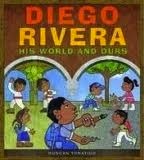
Diego Rivera, His World and Ours
Written and Illustrated by Duncan Tonatiuh
Abrams, 2011, pp. 33
ISBN: 978-0810997318
Diego Rivera, His World and Ours, is the winner of the 2012 Pure Belpre Award for illustration given by the American Library Association. In only a few pages, the book describes Rivera’s love of drawing as a child and his travels to Spain, where he studied classical realistic art form, and to France, where he studied new methods such as cubism. This book for young readers focuses on Rivera’s paintings, especially his murals, and the influences and significance of his work. Tonatiuh uses his own unique style, a mixed media collage form that employs ancient Mexican motifs and blocky figures, to interpret some of the major works of Rivera for young readers. His focus on Rivera’s love of Mexican culture, enhanced by travels within his country, is found in Tonatiuh’s interpretation of paintings such as The History of Mexico, La Zandunga, or The Ribbon Dance. Tonatiuh’s continuous important question of what would Diego paint if he were alive today asks readers to make connections between the artistry and intent of Rivera and their own communities. Possible examples in response to this question are illustrations of the big city, street vendors, or the luchadores wresting in their costumes. Spanish names and terms are integrated throughout the book. Information provided at the end of the story includes a glossary, author’s note with further Rivera history, places to find Rivera’s paintings, a bibliography and inspirations (listing of the actual paintings and their locations that inspired the illustrations within the book).
While the book shares the importance of Rivera’s work as representations of the culture and history of Mexican people, it is the realization of the potential of purposeful art for young readers that makes this book an outstanding resource. Themes of art, creating socially just communities, and a call for action are evident and accessible for the young as shown in this text from the final pages:
Diego’s murals teach us about the past. But they also show a better future for common people. Diego imagined everyone—men and women, boys and girls, of all ages and nationalities-living together and caring for one another. Today Diego is not around to make this happen. So it is up to us to make our own murals and bring them to life (p. 28-29).
Duncan Tonatiuh was born in Mexico City and grew up in San Miguel de Allende, Mexico. Graduating from the Parsons New School for Design in New York City, he spends time both there and in Mexico. Inspired by Ancient Mexican art of the Mixtec codex, he states his aim is “to create images that address contemporary issues that affect people of Mexican origin on both sides of the border” (http://www.duncantonatiuh.com/about.html). It appears only natural that he would be influenced by the social commentary murals of Rivera.
Diego Rivera, His World and Ours can be read with other biographies of this well-known artist as readers learn about perspective and different ways to tell the story of a life. Titles such as Diego (Jonah Winter, 2007), Diego: Bigger than Life (Carmen T. Bernier-Grand, 2009), and Diego Rivera (Mike Venizia, 1994) offer young readers insights to Rivera’s life. This book might also be used to nurture the arts as a semiotic form as young learners consider ways that art has been instrumental in people’s cultures. Books to help support this purpose might be In Her Hands, the Story of Sculptor Augusta Savage (Alan Schroeder, 2009), The Secret to Freedom (Marcia Vaughn, 2001), Dave the Potter: Artist, Poet, Slave (Laban C. Hill, 2010), and Woody Guthrie, Poet of the People (Bonnie Christensen, 2001).
Janelle Mathis, University of North Texas, Denton, TX
WOW Review, Volume IV, Issue 3 by Worlds of Words is licensed under a Creative Commons Attribution-NonCommercial-ShareAlike 4.0 International License. Based on work at https://wowlit.org/on-line-publications/review/iv-3/

Deborah,
I appreciate that you bring your knowledge and experiences in Haiti to bear as you commented on the language Nick Lake uses and the accuracy of the historical figures he references.
I started the book after hearing Lake speak at ALA Midwinter in January – but the story was just too dark for me at the time. Perhaps, after reading your review, I will pick it up again.
Thank you for your insights.